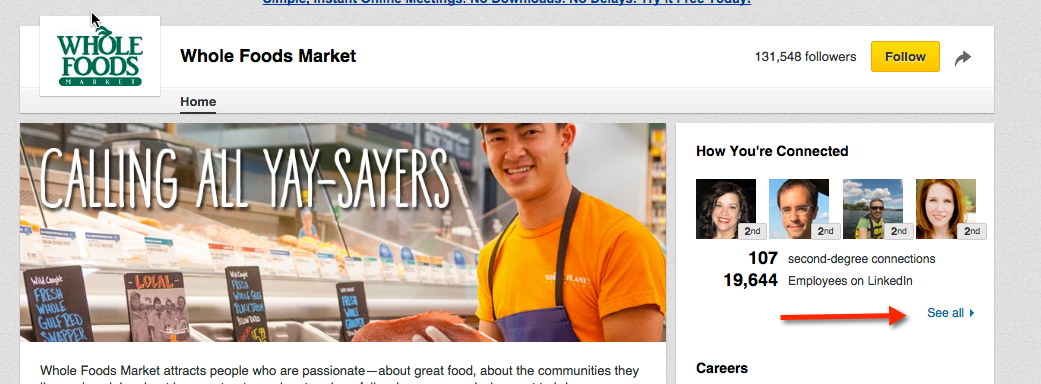How to Increase Available Selling Time with LinkedIn
According to CSO Insights’ Sales Optimization Study, B2B sales people typically spend a startling 59% of their time NOT selling. What are they doing? The chart above shows you what the breakdown looks like.
Researching prospects and their companies seems to take such a huge chunk of time because sales people generally check eight sources to get a good understanding of the prospect before reaching out to them. I agree this understanding is vital to successfully a) get their attention and b) establish a relationship; but here’s the good news, it really doesn’t require so many sources and so much time. In most cases you can get what you need right from LinkedIn.
The world’s most accurate business database
Even with 340 million members (and growing literally every second) LinkedIn may not be the largest database you could access, but it is far and away the most accurate for one simple reason – we each control our own profiles and few people let them get old.
One of the first things most people do when they get a promotion or change jobs is to update their LinkedIn profile. This means what you see when you research someone on LinkedIn is refreshingly accurate, generally within a month or two and usually less.
Pretty darn good search
Many sales people tell me they start with a conventional commercial database to identify prospects and then move to LinkedIn to learn more about them. But LinkedIn now has an incredibly powerful built in search engine that often makes that first step completely unnecessary. There are plenty of good articles out there explaining in great detail how to use LinkedIn search. I suggest starting here.
One challenge of LinkedIn search is access to members, which is established by both the size and quality of your own personal network and, basically, how much you’re paying for your LinkedIn account. Not surprisingly, free accounts are limited in how many “degrees” of contacts you can view; while Sales Navigator accounts allow you to see far more people.
LinkedIn Profiles - everything you want to know about me
Granted, some LinkedIn profiles are woefully incomplete but more and more people are getting serious about expanding their profiles; and the information on even the most barren profile is almost always accurate, which is more than you can say for most conventional sales intelligence sources.
In addition to getting the latest basic details such as company and title, you can learn a great deal about a person just by reading a good profile. What are their job responsibilities and objectives? What accomplishments are they proudest of? How long have they held this and similar positions? This information easily translates into an educated hypothesis about business issues, problems, solutions and insight that are most likely to interest this person.
You can also gain useful intelligence about when and how to approach this person. Are you in any of the same groups? (At the time of this writing, LinkedIn allows members of the same group to send messages to each other.) Have you worked at the same or similar companies? Did you go to the same school? What non-profits do they support via volunteer work?
Company Pages – fewer clicks than a website
Although apparently there are still a surprising number of companies that don’t have a LinkedIn company page, I rarely run across one of those – especially among medium and enterprise sized companies, which are the most confusing to research anyway. For the sales pro, a company page provides quick access to the corporate overview, and a well-kept company page will feature the latest news and content updates.
In the upper right-hand corner of the company page you’ll also find a quick link to a listing of all the company’s employees with LinkedIn profiles. Depending upon what type of LinkedIn account you have, you can easily narrow down the list of employees to find others you may be looking for.
Bonus intel: In the middle of the right-hand corner of the company page you’ll also find a list of other company pages people have visited before or after they look at the page you’re looking at. Quite often you’ll find the company’s most important competitors on that list.
Keeping your info up-to-date
One of the biggest time savers of all is found within the monitoring function in Sales Navigator. Once initial information has been gathered you can use this functionality to stay informed about changes in the professional lives and companies of your prospects. Just save prospects as Leads within Sales Navigator and you’ll receive a notification whenever they change jobs or titles or otherwise update their profiles. Save companies as accounts and you’ll be notified of any news published by or about that company.
What could be easier?
Saving more than time
According to a visual.ly compilation of data, over 8 in 10 sales teams feel challenged by the amount of data and time it takes to research a prospect. Even with all the time sales people spend researching, 88% of colleagues think their sales team has missed some or many opportunities because they can’t gather all the prospect information they need to close a deal.
At risk of minimizing what truly is an important element in a successful sale, it doesn’t have to be so complicated. When researching accounts or prospects for our own efforts or those of our clients, we tend to visit company websites in addition to LinkedIn; but rarely is any other source required. Using these two sources, we can get an accurate and well-rounded view of a prospect in a matter of minutes.
The only thing LinkedIn won’t help you with is determining the revenue of a privately held company. Nothing is perfect.
Further reading:
How to Use LinkedIn for Account Management
Is Sales Navigator Worth the Investment?



